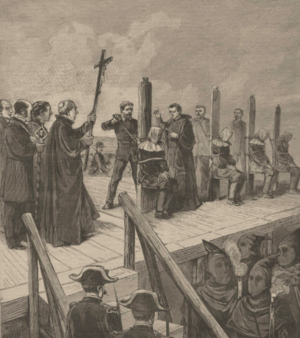Capital punishment in Creeperopolis

| Part of a series on |
| Human rights in Creeperopolis |
|---|
 |
|
Outline |
Capital punishment (Creeperian Spanish – Creeperian: պենալ ծապիտալ; Creeperian Spanish – Iberic: penal capital; Creeperian Spanish pronunciation: [peˈnal ka.piˈtal]; literally: capital penalty) is a legal penalty in Creeperopolis which is currently constituted and applied in all thirty departments of Creeperopolis, as well as by the Creeperian Armed Forces (FAC), and even in some cases by the Creeperian National Police (PNC). Creeperopolis has been noted as the most frequent utilizer of capital punishment in the world. It is one of the thirteen nations which have capital punishment as a legal penalty and is one of six which have carried out at least one execution since 2020.
The history of capital punishment in Creeperopolis can be traced to the Kingdom of Xichútepa (1650BC–1578BC), in the form that individuals accused of offending or blaspheming the gods were sacrificed. The first definitive case of a formal execution for a "crime" of any sort can be traced to be the Creeperian Confederation (220BC–537AD) where individuals who murdered another were publicly beheaded or sometimes sacrificed. In modern Creeperopolis, capital punishment has existed since the establishment of the monarchy in 1231 and has only been abolished in two periods, between 1729 and 1771 and again between 1888 and 1893.
Every year since 1893[note 1] has had an official and reliable figure about how many executions were carried out by the Creeperian government, however, the figure fails to include many wartime executions which have occurred as a part of the Creeperian Conflicts. In 2020, the Creeperian government official executed 10,974 people, the highest figure on any nation and the highest figure since the Creeperian government executed 12,982 people in 2003.
Various methods of execution have been used throughout Creeperian history, such as hanging, beheading, shooting, crucifixion, keelhauling, via the garrote, stoning, among many more methods. Various crimes are also punishable by capital punishment, such as abortion, terrorism, espionage, heresy, regicide, drug trafficking, waging war on God, practicing atheism, among many other crimes. Capital punishment is constitutionally protected, as are various capital crimes, which are labelled as "constitutional crimes."
Contents
- 1 History
- 2 Capital crimes
- 3 Methods of execution
- 4 Legal process
- 5 Execution attendance
- 6 Clemency and commutations
- 7 Number of executions per year
- 8 See also
- 9 Notes
- 10 References
- 11 External links
History
Proto-Creeperian and Confederation eras
Old Kingdom and Emirate eras
Old absolute monarchy
First Parliamentary Era
Middle absolute monarchy
Second Parliamentary Era
During the Creeperian Civil War
Modern Creeperopolis
Opposition to and violations of TCN Resolution 010
Capital crimes
Constitutional crimes
Other capital crimes
Methods of execution
Currently in use
Ten methods of execution are still in use in Creeperopolis:
- Beheading
- Crucifixion
- Drawing and Quartering
- Falling from Helicopter
- Firing Squad
- Garrote
- Gas Inhalation
- Hanging
- Stoning
- Sawing
Of the methods of capital punishment still in use, firing squad and hanging are the most common. Methods such as stoning and sawing are very rare, but are commonly used in vigilante executions. Crucifixion is also rarely used and is mostly used in "ceremonial" executions, such as executions of individuals of high importance or prominence.
Another method is de facto still used by the Creeperian government: burning. Although TCN Resolution 010 banned the use of fire in executions, the Creeperian government has continued to burn people as a form of execution. Burning was de jure removed as a method of execution, however, it is still used, especially in southern Creeperopolis.
Former methods
Seventeen methods have been formerly used that have been recorded.
- Boiling
- Breaking Wheel
- Burying
- Crushing
- Death by Animals
- Dehydration
- Disembowelment
- Dismemberment
- Drowning
- Flaying
- Impalement
- Ingesting Molten Metal
- Keelhauling
- Pánfilo Coffin
- Poisoning
- Slow Slicing
- Strangulation
Legal process
Execution attendance
Clemency and commutations
Number of executions per year
1893–1932
1958–2002
2003–present
See also
Notes
- ↑ Excluding 1933–1957.
